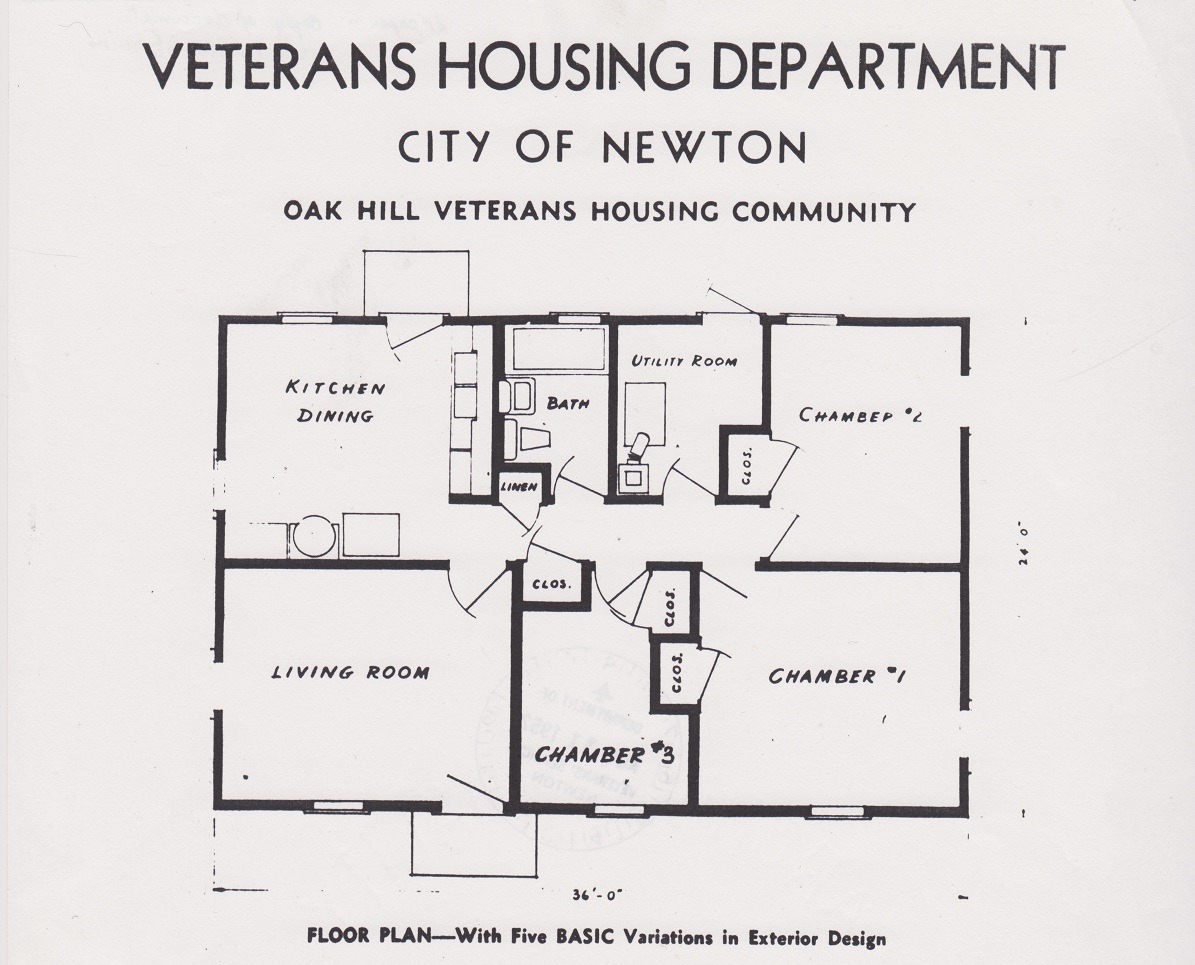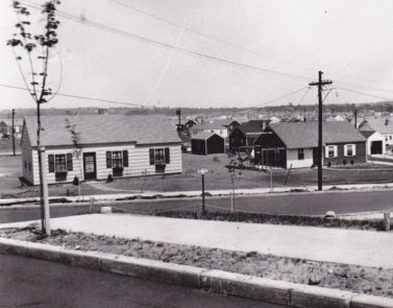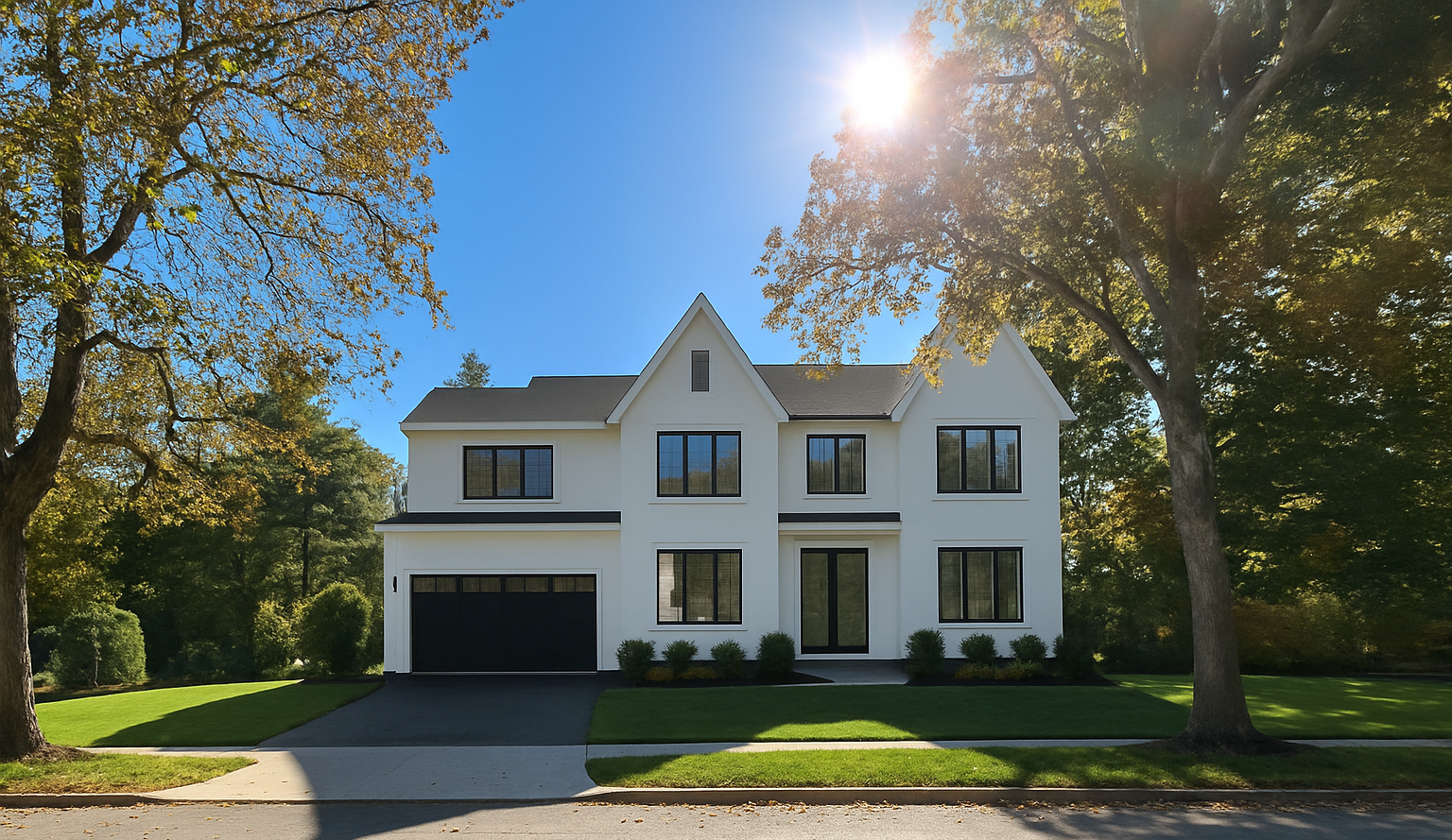Brief History
Oak Hill Park is a residential subdivision located in the southernmost part of Newton, at the Boston (West Roxbury) line. The site was previously a gravel pit (Highland Sand & Gravel) and after World War II the City of Newton developed it as a planned subdivision for returning veterans. Specifically: “In January 1948 … a tract of land … was chosen … consisting of 412 homes, a small shopping center and a school” for returning Newton veterans.
The neighborhood is unique in that it is the only planned development village. It is also the newest village. Oak Hill Park (OHP) included a unique element: street-path names honoring Newton’s WWII servicemen.

Village Character & Lifestyle
Oak Hill Park offers a “neighborhood within a neighborhood” feel: self-contained subdivision with its own shopping center, school, playgrounds and strong community identity.
The original housing stock consisted of modest one-story three-bedroom houses built on concrete slabs with radiant heat, which were then remodeled/expanded over time. Because these were modest homes on good size lots, over recent years, these homes are getting scooped up by builder, razed and replaced with large, new construction homes. The village has hit a tipping point where at least half the original homes have been replaced.
The end of Oak Hill Park that abuts Dedham St belonged to Esty Farm at the time. A few years after Oak Hill Park was purchased, that land was sold to a builder who created another, smaller development of later mid-century multi-level homes that were larger than the original OHP homes.



Because of its planning origin and distinct history, Oak Hill Park has a different character than older Newton villages: more uniform lot-planning, mid-century architecture, evolving into mixed housing styles. The village was very self-contained with its own school, post office, shopping plaza, and gas station.
Schools & Community
Oak Hill Park falls under the broader Newton Public Schools district. The neighborhood’s design included a dedicated school (Memorial School) to serve children of the veterans’ community. This school is now a private Jewish school – Solomon Schecter. The adjacent playground remains the property of the city and is available to the residents of Oak Hill Park.
Public school students here now attend Memorial-Spaulding elementary school, Oak Hill Middle School and Newton South High School.
The presence of Oak Hill Park Association (OHPA) and strong resident engagement is part of its historic identity. This association has a Facebook group that residents can join to share information.
Location & Commute
Positioned near the southern border of Newton with Boston, Oak Hill Park abuts West Roxbury and offers relatively easy access to major routes and city connections.
The only public transportation available is the 504 bus line that takes residents to Newton Center where they can catch the Green Line.

Parks & Sites of Interest
Oak Hill Park’s design includes wide roads, green spaces, tree-lined streets, walking trails along the Charles River (Saw Mill Brook Parkway leads to walking trails) and a playground.
Oak Hill Park is enclosed on one side by UMass Mt Ida campus, on the other by the Baker St Jewish Cemetery. On the end, by the Charles River and adjacent greenery, so the only way in or out is via Dedham St. No one goes in or out of Oak Hill Park unless they live there or are vising someone who lives there so it has a very cozy, hometown feel.
Demographics & Income
Oak Hill Park real estate is a mix of original small homes, medium-sized (3-4 bed) to large (4+ bed) single-family homes. There are roughly 450 homes in this village. Part of the shopping plaza was converted to condos and that is the only non-single family residency in OHP.
Median listing home price (as of this year) is ~ $2.84 million
The pricing demonstrates that while Oak Hill Park started as modest post-war housing, it has appreciated significantly and now sits in a premium bracket.
Housing Market & Home Ownership
Oak Hill Park offers some entry points compared to the most elite Newton villages, but still commands premium pricing due to location, school district and community character.
Ownership is high; the homes tend to be single-family with some redevelopment taking place (large lot subdivisions, expansions).
What This Means for Buyers & Sellers
For Buyers:
This is an attractive neighborhood for those wanting Newton village living with a slightly different price-point and history. Be prepared to go up against builders for the older stock of homes.
For families: the strong school district plus family-friendly environment make Oak Hill Park a compelling choice.
For value-seeking buyers: explore homes that need updating or expansion — the lot and location are excellent foundation.
For Sellers:
Use the narrative: “Planned community for veterans turned premium Newton village; strong schools; evolving neighborhood with value and appeal.”
Pricing strategy: reflect the neighborhood’s upward trajectory, but also its unique history and relative opportunity (vs ultra-elite villages).
Leverage community aspects: neighborhood association, trails, family amenities — many buyers value that intangible.
In Summary
Oak Hill Park stands out as a distinctive Newton village: post-war planned, neighborly, evolving from modest veterans housing into a sought-after residential enclave. For buyers, it offers value + Newton schools + strong community; for sellers, it gives the chance to highlight unique story + modern appeal + strong demand. As a broker, your key message is: “Not just a house in Newton — a home in Oak Hill Park with story, identity and future.”
Related Links
Since Oak Hill Park is in the Newton Center zip code (02459), it is not possible to break out just OHP listings to display here. However, here is a list of streets in OHP (along with the soldier they were named after) so that you will know if a home you are looking at online is contained here.
| Antonellis Circle | Joseph T. Antonellis (1916–1944) | Corporal, United States Army, Chemical Warfare |
| Avery Path | George L. Avery (1925–1945) | |
| Bontempo Road | Peter A. Bontempo (1922–1945) | Private First Class, United States Army |
| Caldon Path | Albert T. Caldon (1918–1944) | Corporal, United States Army |
| Callahan Path | William F. Callahan, Jr. (1920–1942) | Second Lieutenant, 85th Mt. Infantry Reg. United States Army (the Callahan Tunnel in Boston was also named after him) |
| Caulfield Circle | John L. Caulfield (1917–1944) | First Lieutenant, United States Army (KIA, Omaha Beach) |
| Cavanaugh Path | Paul R. Cavanaugh (1921–1944) | Sergeant, United States Army Air Forces, Tailgunner B24 Liberator |
| Chinian Path | Sarkis Chinian (1924–1945) | Private First Class, United States Marine Corps |
| Cibel Path | Harvey J. Cibel (1918–1943) | Second Lieutenant, United States Army Air Forces |
| Colella Road | Russell C. Colella (1913–1944) | |
| Considine Road | Wilfred B. Considine (1920–1944) | Technical Sergeant, United States Army Air Forces |
| Early Path | Lawrence Early (1896–1944) | Captain, United States Army |
| Esty Farm Road | Amos Esty | original owner of Esty Farm, who purchased the land sometime between 1848[10] and 1855[11] |
| Fredette Road | Francis A. Fredette (1906–1944) | CM 1/c United States Navy |
| Hanson Road | Robert M. Hanson (1922–1944) | First Lieutenant, United States Marine Corps Aviation (Medal of Honor)[12][13][14] |
| Hay Road | John S. Hay (1919–1943) | United States Army Air Forces |
| Kappius Path | Mainolph Valen Kappius (1899–1945) | Commander, Medical Corps, United States Navy Reserve (Flight Surgeon) |
| Keller Path | H. Russell Keller, Jr. (1916–1945) | Lieutenant, United States Navy Aviation |
| Kerr Path | William J. Kerr (1921–1942) | Electrician’s Mate, 3/c United States Navy |
| McCarthy Road | Francis P. McCarthy (1917–1942) | Captain, United States Marine Corps Aviation (Distinguished Flying Cross) |
| Nightingale Path | William E. Nightingale (1924–1945) | Flight Officer Royal Canadian Air Force |
| O’Connell Road | Frederick P. O’Connell (1921–1944) | Corporal, VMCR Class III-C |
| O’Rourke Path | John J. O’Rourke (1908–1942) | Specialist 5/c United States Army |
| Osborne Path | William H. Osborne (1913–1945) | Sergeant, United States Army Air Forces |
| Shumaker Path | Robert Shumaker (1924–1944) | Ensign, United States Navy Aviation – 2nd Lt. United States Marine Corps (NAVC) |
| Shute Path | George B. Shute (1923–1945) | Private, United States Army |
| Spiers Road | William A. Spiers (1924–1944) | Private First Class, United States Marine Corps |
| Stein Circle | Robert F. Stein (1920–1944) | Co. C 101st United States Army |
| Timson Path | Frederick H. Timson, Jr. (1906–1945) | Private, United States Army Air Forces |
| Tocci Path | Nicholas Tocci (1920–1945) | Private, United States Army |
| Van Roosen Road | Hugh Van Roosen (1922–1943) | LTJG, United States Navy (Purple Heart and Navy Cross). Graduate of United States Naval Academy. |
| Van Wart Path | Paul H. Van Wart (1922–1945) | Sergeant, United States Army Air Forces |
| Walsh Road | George E. Walsh (1906–1945) | |
| Wiswall Road | Noah Wiswall (1699–1786) and Jeremiah Wiswall (1725–1809) | Captain, East Newton Company of Minutemen, Concord and Dorchester, American Revolutionary War. Noah Wiswall was wounded at the Battle of Lexington.[3][15][16][17] |
| Young Path |
